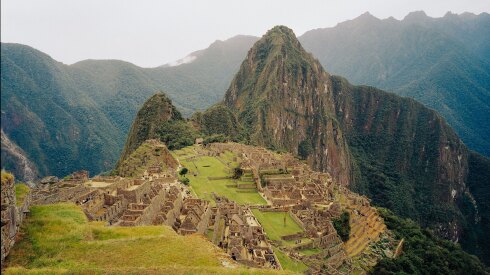9 Reasons to Visit Ireland
There are hundreds of reasons we love Ireland, from the dramatic coastlines with their remote, beaches to the peat bogs, ruins and prehistoric sites dotted around the country. When you visit, you can see deer in the park, walk the cliffs, go horseback riding on the beach or tour a whiskey distillery. Visitors to Ireland will also love the cultural traditions like music sessions, storytelling and poetry, as well as lively pubs and meeting friendly Irish locals. Here are some of the country’s best highlights.
Letterfrack, Co. Galway, Ireland
The bleak, windswept landscape of Connemara in the West of Ireland is characterized by bogs, lakes, mountains, and miles of stone walls. Connemara National Park is one of the best places to appreciate this unique landscape, with more than 7,000 acres of national park encompassing mountains, including some that are part of the Twelve Bens range, plus Western blanket bog and treeless plains that are home to red deer, sheep, and Connemara ponies. Explore for yourself, and find traces of history dating back thousands of years, including 4,000-year-old megalithic tombs and abandoned farms.
Lislorkan North, Co. Clare, Ireland
Fancy yourself a brave one, do ye? Aye, aye, then the Cliffs of Moher are right up your alley. Ireland‘s most popular tourist destination does not disappoint, though visiting during the middle of the day means you’re going to have to share the walking paths with plenty of other folk - most of them American visitors in their finest Notre Dame Fighting Irish t-shirts. Come early in the morning or late in the afternoon and you’ll have the cliffs, beautiful light, and ancient rock monsters all to yourself. That’s right; rock monsters. That’s one giving tourists the finger right there in the ocean.
Sligo, Ireland
As a child, William Butler Yeats spent his summer holidays in County Sligo, and the lakes and hills inspired many of his most famous poems, such as The Lake Isle of Innisfree. Take a leisurely day and follow the Yeats Trail around the locations in the area that he loved, taking in Glencar Lough, the Isle of Innisfree, Rosses Point, Benbulben, Lissadell House, and finally the churchyard at Drumcliffe Parish Church, where Yeats is buried.
Church Hill, Letterkenny, Co. Donegal, Ireland
Glenveagh National Park is one of the highlights of the northwest of Ireland. A number of walking trails traverse the 62 square miles of rugged mountains, lakes, remote bogs, and woodlands, where wildlife such as red deer and golden eagles roam. The centrepiece is Glenveagh Castle (you can take a guided tour or just drop into the tea rooms) and its formal Italianate and rose gardens. There’s a shuttle bus from the car park to the castle but the walk is worth doing if the weather is suitable, to really experience the magnificent surroundings.
Main St, Magheracar, Bundoran, Co. Donegal, Ireland
Drive down a country road in County Donegal toward the sea, and you’re likely to find miles of unspoiled golden beach – and if there are waves, the water might be filled with surfers. Pounded by the big swells of the Atlantic Ocean, the northwest of Ireland is one of the best surfing spots in Europe and surfers take to the waves year round, with the biggest swells during winter. The unofficial surf capital is Bundoran in south Donegal. Tullan Strand is a popular beginner spot – you can rent boards or take lessons from one of the town’s four surf schools – while the reef break at The Peak is for more advanced waveriders. The 3km beach at Rossnowlagh, 20km up the coast, is reliable for regular waves and home to one of the country’s first surf clubs. Further north in the county, there are more challenging surf spots at Dungloe, Dunfanaghy, Inishowen and Fanad Head. The Bridge Bar in Bundoran town is the ideal post-surfing recovery spot for bowls of creamy seafood chowder, pints of Guinness and a surf cam so you don’t miss any of the action on The Peak, or walk up the cliff road from Rossnowlagh beach to the Smuggler’s Inn for reviving post-surf refreshments.
College Green, Dublin 2, Co. Dublin, Ireland
Pass through the iconic arched doorway at College Green and enter the elegant quads, handsome architecture and verdant lawns of Trinity College, one of Ireland‘s most prestigious universities. Among its many attributes is the atmospheric 18th-century Old Library, whose most precious tome is the 1,200-year-old Book of Kells, a priceless illuminated manuscript. Also worth a visit are the college’s Douglas Hyde Gallery, devoted to contemporary art, and the thought-provoking Science Gallery.
Glendalough, or Gleann Dá Loch in Irish (which means “valley of two lakes”), is a quiet, picturesque valley near the Wicklow Mountains. Its 6th-century monastic settlement founded by St. Kevin is one of the most important in Ireland, and it’s surrounded by dewy grass and heather, lush hills, mossy rocks, and an impressive variety of wildlife. Monastic City itself includes the remains of ancient stone churches, a priests’ house, a stone fort, and a 100-foot round bell tower. The cemetery is fascinating with its lichen-covered headstones tilted every which way amid unkempt vegetation. Generations of Irish family histories are contained in this small plot of land, which is an integral part of this site. Glendalough is about 90 minutes’ south of Dublin and makes for a worthwhile day tour that includes sightseeing and hiking followed by a visit to a cozy local pub.
















